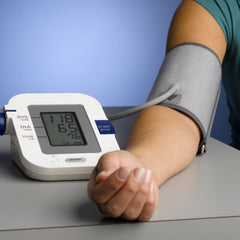Two Groups Who Should Be Concerned About Elevated Blood Pressure
Table of Contents:
- Elevated Blood Pressure: A Hidden Burden on the Heart and Vessels
- Two High-Risk Groups to Watch
- Scientific Strategies to Keep Blood Pressure in Check
- Strict Monitoring for High-Risk Individuals
- Limit Salt Intake
- Stretching After Prolonged Sitting
- Engage in Regular Weekly Exercise
- Waistline Control is Crucial
- FAQs about Prehypertension
During routine health check-ups, many individuals are told their blood pressure is “a bit high.” However, since it doesn’t meet the clinical threshold for hypertension, it is often overlooked. In fact, this condition is known as "high-normal blood pressure" or prehypertension. Although it doesn’t yet qualify as hypertension, it silently increases strain on the cardiovascular system, posing long-term health risks. This is especially concerning for middle-aged adults and women, in whom such borderline blood pressure may significantly elevate the risk of stroke, heart disease, and other serious conditions.
So, how dangerous is high-normal blood pressure? Who should be especially vigilant? And how can we scientifically manage it to keep blood pressure under control?

Elevated Blood Pressure: A Hidden Burden on the Heart and Vessels
High-normal blood pressure, or prehypertension, refers to a borderline condition where blood pressure falls between normal levels and those required for a hypertension diagnosis—specifically, systolic pressure between 120–139 mmHg and/or diastolic pressure between 80–89 mmHg.
Studies show that individuals with high-normal blood pressure have a 4% increased risk of all-cause mortality and a 28% higher risk of cardiovascular-related death. The risk is particularly elevated in adults aged 35–54 and women. For example:
- Middle-aged adults with high-normal BP face a 2.75-fold higher risk of death from hemorrhagic stroke.
- Women in this category have a 40% higher mortality rate compared to the general population.
Although these individuals do not yet meet the criteria for a hypertension diagnosis, their cardiovascular systems are already experiencing increased stress. If left unmanaged, this condition can progress to arterial stiffening, increased blood volume, and greater cardiac workload.
Importantly, most people with high-normal BP do not exhibit obvious symptoms. A few may experience occasional headaches, dizziness, or palpitations, but these nonspecific signs are often ignored—allowing the disease to progress silently.
Without intervention, approximately 50% of individuals with high-normal BP will develop hypertension within five years, increasing the risk of damage to vital organs such as the heart, brain, and kidneys.
Two High-Risk Groups to Watch
High-normal blood pressure has several contributing risk factors: aging, genetics, obesity, high-salt diets, sedentary lifestyle, alcohol abuse, and chronic stress. However, two specific groups deserve special attention:
Women
Women's blood pressure is closely tied to hormonal fluctuations throughout different life stages.
Estrogen acts as a "protective shield" for blood vessels. After menopause, estrogen levels drop significantly, reducing this protection and making blood vessels more sensitive—raising the likelihood of increased blood pressure.
Pregnancy is another vulnerable period, during which some women develop gestational hypertension.
In addition, women may face higher risk due to factors like more active sympathetic nervous systems, narrower arteries, and greater vascular resistance compared to men.
Adults Aged 35–54
This age group is particularly vulnerable to cardiovascular risks from elevated blood pressure due to the following reasons:
-
Disrupted metabolic rhythm: Many people in this group have irregular lifestyles, including staying up late. Chronic sleep deprivation raises cortisol levels, leading to water and sodium retention and increased blood volume.
-
Dietary habits: A tendency toward high-salt and high-calorie diets contributes to vascular damage.
-
Compensatory cardiac hypertrophy: Even without obvious symptoms, echocardiograms often reveal left ventricular wall thickening and impaired diastolic function, adding to the heart’s burden.
Scientific Strategies to Keep Blood Pressure in Check
For individuals with elevated blood pressure or those in high-risk groups, lifestyle changes are key to reducing the risk of adverse cardiovascular events.
Strict Monitoring for High-Risk Individuals
Those with a family history of hypertension, diabetes, or obesity need targeted management. For example, diabetic patients should not only control blood glucose but also strictly limit salt intake and avoid exercising on an empty stomach to prevent fluctuations in blood sugar.
Limit Salt Intake
Aim for less than 5 grams of salt per day—roughly the amount that fits in a beer bottle cap. Distribute salt intake evenly across three meals.
Stretching After Prolonged Sitting
Avoid prolonged periods of walking, standing, sitting, or lying down. If you sit for long hours, try standing up and stretching your calves or doing tiptoe exercises for 3 minutes every hour.
Engage in Regular Weekly Exercise
Physical activity is a highly effective, non-drug way to lower blood pressure. Recommended regimens include frequent, short, low-intensity sessions, such as brisk walking for 30 minutes a day, 5 days a week. The key is to maintain a moderate level of exertion.
Waistline Control is Crucial
Managing body weight—especially waist circumference—is vital. Keep waist circumference below 90 cm for men and 85 cm for women.
FAQs about Prehypertension
Can Prehypertension Be Reversed?
Yes, prehypertension can often be reversed, especially with timely lifestyle changes. Key steps include losing excess weight, increasing physical activity, following a heart-healthy diet such as the DASH diet, and managing stress.
What Causes Prehypertension?
Prehypertension can be caused by various lifestyle factors such as obesity, lack of physical activity, high sodium intake, insufficient sleep, and chronic stress. In addition, a family history of high blood pressure and underlying medical conditions can also increase the risk of developing prehypertension.
What are the Symptoms of Prehypertension?
Prehypertension usually has no noticeable symptoms, which means most people don't realize they have it. The only way to know if you have prehypertension is by regularly checking your blood pressure.
Can Prehypertension Cause Dizziness?
Prehypertension usually has no noticeable symptoms, which is why many people are unaware they have it. However, some individuals may experience occasional dizziness, which can be a subtle sign of rising blood pressure.
Can Stress Cause Prehypertension?
Chronic stress can contribute to the development of prehypertension. When the body is under constant stress, it remains in a heightened state of alert, which can lead to consistently elevated heart rate and blood pressure. Over time, this prolonged physiological response can strain the cardiovascular system and increase the risk of developing prehypertension.





